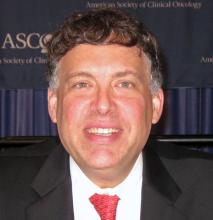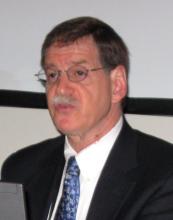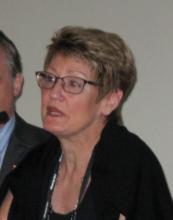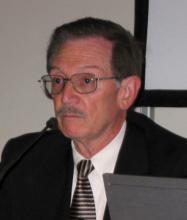User login
AMSTERDAM – The International Association for the Study of Lung Cancer has issued a call for physicians to discuss lung cancer screening with patients who match the high-risk smoking history of the people enrolled in the landmark National Lung Screening Trial.
The National Lung Screening Trial (NLST) showed that an annual, low-dose CT chest scan can lead to significant reductions in lung cancer deaths and overall mortality in patients aged 55-74 years who smoked for at least 30 pack-years and, if former smokers, quit within the prior 15 years (New Engl. J. Med. 2011 [doi: 364:10.1056/NEJMoa1102873).
Based on these unprecedented findings, the International Association for the Study of Lung Cancer (IASLC)’s position-writing committee issued a call for physicians to discuss the data and its implications with such patients.
"It is appropriate for heavy smokers ages 55 to 74 to discuss relevant lung cancer screening information with their physicians to assist them in deciding whether to undergo spiral CT screening," said the statement, issued as IASLC started its world conference
Although some committee members, including the chairman, urged caution when routinely discussing screening with the target population before the cost effectiveness of this approach is proven, two of the Americans on the 10-member position-statement writing committee endorsed immediately offering screening to fully informed people who match the study’s screening profile.
"For patients with metastatic lung cancer the cure rate is essentially zero. Finding lung cancer early is the best way to deal with this disease, and that’s why this is such an extraordinary result," said Dr. Roy S. Herbst, a member of the task force and chief of medical oncology at Yale University in New Haven, Conn.
"Even with all the cautions, I think that in the United States at least you’ll see screening, especially since the NLST was largely sponsored by the National Cancer Institute. Assuming that the CMS [Centers for Medicare and Medicaid Services] and insurers will pick this up, I think [screening] is something we’re going to see. I think there will be great pressure in the United States for this to be covered, at a cost of about $300-$400 per scan.
"At Yale, we’ll start screening people who meet the enrollment criteria for the trial, as will several other U.S. centers. We’ll offer screening with all the caveats," including informing patients about the risks they will face from screening, their need to stop smoking, their need for ongoing screening, and the need to have a multidisciplinary team in place at the screening site to deal with all the possible consequences of screening, Dr. Herbst said.
"We know there is effectiveness from screening, but is there cost effectiveness? Is there value?" asked Dr. Richard Gralla, another member of the statement-writing committee and chief of hematology-oncology at North Shore University Medical Center and Long Island Jewish Medical Center in New Hyde Park, N.Y.
"My prediction is that screening will not only be shown to be cost effective, but it will be very cost effective. It will also be very expensive" to run annual screens on the millions of middle-aged smokers who meet the trial’s screening profile, he added. The NLST report estimated that 7 million Americans match the age and smoking history of the people enrolled in the trial.
By thrusting medicine into a new era of routine lung cancer screening, these developments will trigger creation of a new system of quality oversight for lung cancer screening that will likely follow the model of breast cancer screening.
"There is a laundry list of requirements that will need to be established by the institutions that want to do CT screening," said Dr. Denise R. Aberle, professor of radiology at the University of California, Los Angeles, and a collaborator on the NLST. "That will likely evolve into a form of accreditation to better guarantee quality assurance, as with breast cancer screening." Dr. Aberle also noted that the NLST researchers collected cost-effectiveness data, and that they will soon release a report on their analysis of those data.
Routine lung cancer screening will also place new responsibilities on the thoracic surgeons who follow up on suspicious lung lesions found though screening, most of which will not be cancers.
"For surgeons it will be a very large challenge to offer correct treatment to patients with very small cancers," said Dr. Jesper Pedersen, a thoracic surgeon at Copenhagen University Hospital. "We’re planning on writing guidelines for surgeons, because they will be at risk by operating on so many patients without lung cancer." The NLST results showed that 96% of suspicious lesions identified by CT screening were not cancers.
"There is potential for physical and psychiatric harm from cancer screening, but the results from many studies of breast cancer screening have shown that the benefits of screening outweigh its harms," said IASLC president David R. Gandara, professor of medicine and director of the thoracic oncology program at the University of California, Davis, in Sacramento.
"We’re in the early days of screening for lung cancer, and we must do everything to make sure that screening is done appropriately and that follow-up is appropriate. But our message to patients about screening is positive. We can’t overemphasize that," Dr. Gandara said.
Dr. Herbst said that he has been a consultant to Genentech, Agennix, Allos Therapeutics, Boehringer Ingelheim, and OSI Pharmaceuticals. He has been on the advisory boards of Amgen, Biothera, Genetics Squared (now Everist Genomics), MedTrust, N-of-One, SunDev, Targeted Molecular Diagnostics, and DiaTech. He has received research grants from Genentech, Amgen, Bristol-Myers Squibb, AstraZeneca, Novartis, OSI, Oncothyreon, Geron, Sanofi-Aventis, Pfizer, and ImClone.
Dr. Gralla and Dr. Aberle had no relevant disclosures. Dr. Pedersen said that he has been on the speakers bureau for Eli Lilly and Roche and received grant support from AstraZeneca. Dr. Gandara said that he has been a consultant to Amgen, AstraZeneca, Biodesix, Bristol-Myers Squibb/ImClone, GlaxoSmithKline, Genentech, Merck, Novartis, Sanofi-Aventis, and Response Genetics; he has received research support from Abbott, Bristol-Myers Squibb/ImClone, Genentech, Lilly, Merck, Novartis, and Pfizer.
AMSTERDAM – The International Association for the Study of Lung Cancer has issued a call for physicians to discuss lung cancer screening with patients who match the high-risk smoking history of the people enrolled in the landmark National Lung Screening Trial.
The National Lung Screening Trial (NLST) showed that an annual, low-dose CT chest scan can lead to significant reductions in lung cancer deaths and overall mortality in patients aged 55-74 years who smoked for at least 30 pack-years and, if former smokers, quit within the prior 15 years (New Engl. J. Med. 2011 [doi: 364:10.1056/NEJMoa1102873).
Based on these unprecedented findings, the International Association for the Study of Lung Cancer (IASLC)’s position-writing committee issued a call for physicians to discuss the data and its implications with such patients.
"It is appropriate for heavy smokers ages 55 to 74 to discuss relevant lung cancer screening information with their physicians to assist them in deciding whether to undergo spiral CT screening," said the statement, issued as IASLC started its world conference
Although some committee members, including the chairman, urged caution when routinely discussing screening with the target population before the cost effectiveness of this approach is proven, two of the Americans on the 10-member position-statement writing committee endorsed immediately offering screening to fully informed people who match the study’s screening profile.
"For patients with metastatic lung cancer the cure rate is essentially zero. Finding lung cancer early is the best way to deal with this disease, and that’s why this is such an extraordinary result," said Dr. Roy S. Herbst, a member of the task force and chief of medical oncology at Yale University in New Haven, Conn.
"Even with all the cautions, I think that in the United States at least you’ll see screening, especially since the NLST was largely sponsored by the National Cancer Institute. Assuming that the CMS [Centers for Medicare and Medicaid Services] and insurers will pick this up, I think [screening] is something we’re going to see. I think there will be great pressure in the United States for this to be covered, at a cost of about $300-$400 per scan.
"At Yale, we’ll start screening people who meet the enrollment criteria for the trial, as will several other U.S. centers. We’ll offer screening with all the caveats," including informing patients about the risks they will face from screening, their need to stop smoking, their need for ongoing screening, and the need to have a multidisciplinary team in place at the screening site to deal with all the possible consequences of screening, Dr. Herbst said.
"We know there is effectiveness from screening, but is there cost effectiveness? Is there value?" asked Dr. Richard Gralla, another member of the statement-writing committee and chief of hematology-oncology at North Shore University Medical Center and Long Island Jewish Medical Center in New Hyde Park, N.Y.
"My prediction is that screening will not only be shown to be cost effective, but it will be very cost effective. It will also be very expensive" to run annual screens on the millions of middle-aged smokers who meet the trial’s screening profile, he added. The NLST report estimated that 7 million Americans match the age and smoking history of the people enrolled in the trial.
By thrusting medicine into a new era of routine lung cancer screening, these developments will trigger creation of a new system of quality oversight for lung cancer screening that will likely follow the model of breast cancer screening.
"There is a laundry list of requirements that will need to be established by the institutions that want to do CT screening," said Dr. Denise R. Aberle, professor of radiology at the University of California, Los Angeles, and a collaborator on the NLST. "That will likely evolve into a form of accreditation to better guarantee quality assurance, as with breast cancer screening." Dr. Aberle also noted that the NLST researchers collected cost-effectiveness data, and that they will soon release a report on their analysis of those data.
Routine lung cancer screening will also place new responsibilities on the thoracic surgeons who follow up on suspicious lung lesions found though screening, most of which will not be cancers.
"For surgeons it will be a very large challenge to offer correct treatment to patients with very small cancers," said Dr. Jesper Pedersen, a thoracic surgeon at Copenhagen University Hospital. "We’re planning on writing guidelines for surgeons, because they will be at risk by operating on so many patients without lung cancer." The NLST results showed that 96% of suspicious lesions identified by CT screening were not cancers.
"There is potential for physical and psychiatric harm from cancer screening, but the results from many studies of breast cancer screening have shown that the benefits of screening outweigh its harms," said IASLC president David R. Gandara, professor of medicine and director of the thoracic oncology program at the University of California, Davis, in Sacramento.
"We’re in the early days of screening for lung cancer, and we must do everything to make sure that screening is done appropriately and that follow-up is appropriate. But our message to patients about screening is positive. We can’t overemphasize that," Dr. Gandara said.
Dr. Herbst said that he has been a consultant to Genentech, Agennix, Allos Therapeutics, Boehringer Ingelheim, and OSI Pharmaceuticals. He has been on the advisory boards of Amgen, Biothera, Genetics Squared (now Everist Genomics), MedTrust, N-of-One, SunDev, Targeted Molecular Diagnostics, and DiaTech. He has received research grants from Genentech, Amgen, Bristol-Myers Squibb, AstraZeneca, Novartis, OSI, Oncothyreon, Geron, Sanofi-Aventis, Pfizer, and ImClone.
Dr. Gralla and Dr. Aberle had no relevant disclosures. Dr. Pedersen said that he has been on the speakers bureau for Eli Lilly and Roche and received grant support from AstraZeneca. Dr. Gandara said that he has been a consultant to Amgen, AstraZeneca, Biodesix, Bristol-Myers Squibb/ImClone, GlaxoSmithKline, Genentech, Merck, Novartis, Sanofi-Aventis, and Response Genetics; he has received research support from Abbott, Bristol-Myers Squibb/ImClone, Genentech, Lilly, Merck, Novartis, and Pfizer.
AMSTERDAM – The International Association for the Study of Lung Cancer has issued a call for physicians to discuss lung cancer screening with patients who match the high-risk smoking history of the people enrolled in the landmark National Lung Screening Trial.
The National Lung Screening Trial (NLST) showed that an annual, low-dose CT chest scan can lead to significant reductions in lung cancer deaths and overall mortality in patients aged 55-74 years who smoked for at least 30 pack-years and, if former smokers, quit within the prior 15 years (New Engl. J. Med. 2011 [doi: 364:10.1056/NEJMoa1102873).
Based on these unprecedented findings, the International Association for the Study of Lung Cancer (IASLC)’s position-writing committee issued a call for physicians to discuss the data and its implications with such patients.
"It is appropriate for heavy smokers ages 55 to 74 to discuss relevant lung cancer screening information with their physicians to assist them in deciding whether to undergo spiral CT screening," said the statement, issued as IASLC started its world conference
Although some committee members, including the chairman, urged caution when routinely discussing screening with the target population before the cost effectiveness of this approach is proven, two of the Americans on the 10-member position-statement writing committee endorsed immediately offering screening to fully informed people who match the study’s screening profile.
"For patients with metastatic lung cancer the cure rate is essentially zero. Finding lung cancer early is the best way to deal with this disease, and that’s why this is such an extraordinary result," said Dr. Roy S. Herbst, a member of the task force and chief of medical oncology at Yale University in New Haven, Conn.
"Even with all the cautions, I think that in the United States at least you’ll see screening, especially since the NLST was largely sponsored by the National Cancer Institute. Assuming that the CMS [Centers for Medicare and Medicaid Services] and insurers will pick this up, I think [screening] is something we’re going to see. I think there will be great pressure in the United States for this to be covered, at a cost of about $300-$400 per scan.
"At Yale, we’ll start screening people who meet the enrollment criteria for the trial, as will several other U.S. centers. We’ll offer screening with all the caveats," including informing patients about the risks they will face from screening, their need to stop smoking, their need for ongoing screening, and the need to have a multidisciplinary team in place at the screening site to deal with all the possible consequences of screening, Dr. Herbst said.
"We know there is effectiveness from screening, but is there cost effectiveness? Is there value?" asked Dr. Richard Gralla, another member of the statement-writing committee and chief of hematology-oncology at North Shore University Medical Center and Long Island Jewish Medical Center in New Hyde Park, N.Y.
"My prediction is that screening will not only be shown to be cost effective, but it will be very cost effective. It will also be very expensive" to run annual screens on the millions of middle-aged smokers who meet the trial’s screening profile, he added. The NLST report estimated that 7 million Americans match the age and smoking history of the people enrolled in the trial.
By thrusting medicine into a new era of routine lung cancer screening, these developments will trigger creation of a new system of quality oversight for lung cancer screening that will likely follow the model of breast cancer screening.
"There is a laundry list of requirements that will need to be established by the institutions that want to do CT screening," said Dr. Denise R. Aberle, professor of radiology at the University of California, Los Angeles, and a collaborator on the NLST. "That will likely evolve into a form of accreditation to better guarantee quality assurance, as with breast cancer screening." Dr. Aberle also noted that the NLST researchers collected cost-effectiveness data, and that they will soon release a report on their analysis of those data.
Routine lung cancer screening will also place new responsibilities on the thoracic surgeons who follow up on suspicious lung lesions found though screening, most of which will not be cancers.
"For surgeons it will be a very large challenge to offer correct treatment to patients with very small cancers," said Dr. Jesper Pedersen, a thoracic surgeon at Copenhagen University Hospital. "We’re planning on writing guidelines for surgeons, because they will be at risk by operating on so many patients without lung cancer." The NLST results showed that 96% of suspicious lesions identified by CT screening were not cancers.
"There is potential for physical and psychiatric harm from cancer screening, but the results from many studies of breast cancer screening have shown that the benefits of screening outweigh its harms," said IASLC president David R. Gandara, professor of medicine and director of the thoracic oncology program at the University of California, Davis, in Sacramento.
"We’re in the early days of screening for lung cancer, and we must do everything to make sure that screening is done appropriately and that follow-up is appropriate. But our message to patients about screening is positive. We can’t overemphasize that," Dr. Gandara said.
Dr. Herbst said that he has been a consultant to Genentech, Agennix, Allos Therapeutics, Boehringer Ingelheim, and OSI Pharmaceuticals. He has been on the advisory boards of Amgen, Biothera, Genetics Squared (now Everist Genomics), MedTrust, N-of-One, SunDev, Targeted Molecular Diagnostics, and DiaTech. He has received research grants from Genentech, Amgen, Bristol-Myers Squibb, AstraZeneca, Novartis, OSI, Oncothyreon, Geron, Sanofi-Aventis, Pfizer, and ImClone.
Dr. Gralla and Dr. Aberle had no relevant disclosures. Dr. Pedersen said that he has been on the speakers bureau for Eli Lilly and Roche and received grant support from AstraZeneca. Dr. Gandara said that he has been a consultant to Amgen, AstraZeneca, Biodesix, Bristol-Myers Squibb/ImClone, GlaxoSmithKline, Genentech, Merck, Novartis, Sanofi-Aventis, and Response Genetics; he has received research support from Abbott, Bristol-Myers Squibb/ImClone, Genentech, Lilly, Merck, Novartis, and Pfizer.
FROM THE WORLD CONFERENCE ON LUNG CANCER



